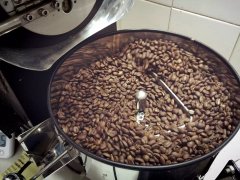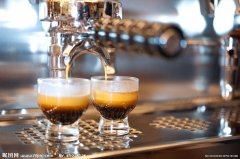The thinking mode of extraction 2b-extraction time is transferred from Douban
Continue with the previous post, http://www.douban.com/note/244706236/
Extraction time, which looks easy, is actually a little more complicated than expected. Because although the extraction time is directly related to the relationship between extraction rate and concentration, their relationship is not necessarily proportional. We still return to the original two purposes, get the reasonable extraction rate and get the proper concentration. Let's start with the extraction rate and then talk about the concentration. In the process, http://www.douban.com/note/239651602/ 's article can be reviewed at any time.
Before we officially get to the topic, we also need to clarify the concept of what exactly is extraction time. This articulation is important because in a narrow sense, low-pressure pre-soaking or steaming is not a formal extraction. For example, many coffee machines calculate the extraction time, excluding pre-soaking. It was only at nine atmospheres that the clock began. But in fact, if the extraction is water in contact with coffee powder to take away the soluble matter, then the extraction time should include any time, the process of contact between water and coffee powder, which naturally covers pre-soaking and steaming.
* extraction rate
If coffee comes into contact with water, the soluble matter in coffee will be gradually taken away with the passage of time. We hope to achieve an extraction rate of 18-21%. At the same time, the maximum amount of substances taken away by coffee will not exceed 30%. Therefore, the relationship between extraction time and extraction rate is proportional. That is, the longer the extraction time, the higher your extraction rate.
Yes, it's very intuitive. But in practical application, many friends make espresso, when debugging, they are more concerned about adjusting the grinder, or fiddling with the amount of powder. In fact, sometimes with a slight change in extraction time, more extraction (higher extraction rate) and less extraction for 2 seconds (lower extraction rate), you will get a completely different effect. How to judge? Since the extraction time is proportional to the extraction rate, under the premise that the amount of powder is the same, you can judge by the espresso liquid color. You can see the color changes during espresso extraction (http://www.douban.com/photos/album/65323274/)

If we use the figure, the arrow indicates the direction of time advance, and the extraction time will be proportional to the extraction rate. It should be emphasized here that with the approach of 30% extraction rate, the extraction rate of soluble matter will be slower and slower. (this will be described in the next chapter. )
* concentration
The longer the extraction time, the higher or lower the concentration? It actually depends on what kind of extraction method, if it is the way of soaking, such as pressure? If we add 10g of powder, we fix about 170g of water. So in the process of contact between the water and the coffee powder, there is no new water filling, which means that the soluble matter in the coffee powder gradually melts into the water. It also means that in this fixed 170g water, the longer the time is, the higher the extraction rate is, and the higher the concentration will be.
What about the way water passes through? That is, a continuous supply of water is extracted through coffee powder, so as the time goes on, the more water passes through, the coffee will be more and more diluted. This can also explain that if you extract it on an Italian machine for 1 minute, you will not only get a very mixed cup of coffee, but also mean that your cup of coffee is relatively light. For example, if you make coffee by hand, you should have extracted 320g of water, but if you extract 500g of water at once, the extraction time of 500g of water will be longer and the taste will be lighter.
Integration
Yes, it's all intuitive. There's nothing new. But as I mentioned at the beginning, the most important thing in making coffee is to get a reasonable extraction rate and concentration. Therefore, when we change the extraction parameters of current coffee, it is very helpful to know whether it is infiltration or soaking. So, let's do an integration.
Back to the basis of extraction. If we use soaking. This means that CBR (the ratio of Coffee Brewing Ratio coffee to coffee liquid) is fixed. Because the amount of powder is put into the kettle, or the siphon pot, this will not change, and the water will not change the amount of powder. Therefore, with the change of extraction time, the extraction point of coffee will move along this line of CBR. That is, with the change of time, the extraction rate and concentration will continue to increase until the extraction rate of 30%.

And the way water passes through? It's a little complicated in the picture. Because water is a continuous supply of coffee powder, and take away the corresponding substances. So the denominator in CBR, the weight of coffee, is changing all the time, which means that CBR is also changing. Of course, one thing we can fix is the amount of powder.
This time, let's take Espresso as an example. (note, it is no longer CBR, but EBF, espresso brewing formula, but the formula is still the same, gram weight divided by coffee gram weight), assuming that in the first second, the coffee liquid comes out of the first drop, then the first drop of gram weight is almost negligible, infinitely small. Then the value of coffee powder weight and coffee liquid ratio (Dose/Espresso Weight) because the denominator is infinitely small, then the whole EBF value is infinitely large, which is an almost vertical line in the figure.

With the passage of time, there is more and more coffee in EBF, which means that the line of EBF begins to tilt downward. Just imagine, if we care about machine extraction for a few minutes, then the line of espresso weight, when coffee is infinitely heavy, means that the line of EBF is almost horizontal.

Another point that needs to be involved here is that people will want to extract espresso. The flow rate is slow at first, and then the flow rate increases as the coffee powder takes away more and more substances. Therefore, with the change of unit time, the tilting speed of EBF is faster and faster.
So what does this mean? The production of the pass type will be very complicated, because if we change the degree of grinding, the extraction point will slide along the line of EBF, and the EBF will change over time. This naturally involves the specific method of extraction. But what we can find is that with the change of time, through the production of class, the extraction rate will be higher and higher, and the concentration will be lower and lower. (changes in red dots on the picture)

Roughly, this is the relationship between the extraction time and the production of coffee, and we will discuss the extraction efficiency in the next chapter. But as I said at the beginning of this series, in the end, no matter what the method is, the purpose of our extraction is to find a reasonable extraction rate and concentration, and the extraction is uniform.
P.S. In fact, there is also a combination, that is, soaking and passing. Like the Smart Cup. You can think about what the change between extraction rate and concentration would be if you started with the extraction time. I will update this picture in a week.
Source: http://www.douban.com/note/261329974/
Important Notice :
前街咖啡 FrontStreet Coffee has moved to new addredd:
FrontStreet Coffee Address: 315,Donghua East Road,GuangZhou
Tel:020 38364473
- Prev

About the degree of grinding: the degree of grinding affects the extraction rate and boiling time.
First, the relationship between the grinding thickness and the extraction time. The finer the coffee is ground, the denser the powder layer is, the more coffee powder particles are in contact with hot water, the extraction resistance increases, it is easier to prolong the extraction time, and the extraction rate is increased, so it is easy to over-extract. On the contrary, the thicker the touch is, the larger the gap in the powder layer is, the less coffee powder is in contact with water, the weaker the extraction resistance, the lower the extraction time and the lower the extraction time.
- Next

About gold cup, talking about the extraction of Coffee
The proportion of SCAA fine cup coffee defined by the Gold Cup Fine Coffee Association of the United States and the scae European Fine Coffee Association must be about 20% of the coffee extraction rate, while the TDS is about 1.1% to 1.3%. For Drip Filter dripping and brewing, how to extract the best coffee flavor is controlled by two variables: the extract of coffee powder and the concentration in a cup of coffee.
Related
- Detailed explanation of Jadeite planting Land in Panamanian Jadeite Manor introduction to the grading system of Jadeite competitive bidding, Red bid, Green bid and Rose Summer
- Story of Coffee planting in Brenka region of Costa Rica Stonehenge Manor anaerobic heavy honey treatment of flavor mouth
- What's on the barrel of Blue Mountain Coffee beans?
- Can American coffee also pull flowers? How to use hot American style to pull out a good-looking pattern?
- Can you make a cold extract with coffee beans? What is the right proportion for cold-extracted coffee formula?
- Indonesian PWN Gold Mandrine Coffee Origin Features Flavor How to Chong? Mandolin coffee is American.
- A brief introduction to the flavor characteristics of Brazilian yellow bourbon coffee beans
- What is the effect of different water quality on the flavor of cold-extracted coffee? What kind of water is best for brewing coffee?
- Why do you think of Rose Summer whenever you mention Panamanian coffee?
- Introduction to the characteristics of authentic blue mountain coffee bean producing areas? What is the CIB Coffee Authority in Jamaica?

